Related Research Articles

A cave or cavern is a natural void in the ground, specifically a space large enough for a human to enter. Caves often form by the weathering of rock and often extend deep underground. The word cave can refer to smaller openings such as sea caves, rock shelters, and grottos, that extend a relatively short distance into the rock and they are called exogene caves. Caves which extend further underground than the opening is wide are called endogene caves.

East Malaysia, or the Borneo States, also known as Malaysian Borneo, is the part of Malaysia on and near the island of Borneo, the world's third-largest island. East Malaysia comprises the states of Sabah, Sarawak, and the Federal Territory of Labuan. The small independent nation of Brunei comprises two enclaves in Sarawak. To the south and southeast is the Indonesian portion of Borneo, Kalimantan. East Malaysia lies to the east of Peninsular Malaysia, the part of the country on the Malay Peninsula. The two are separated by the South China Sea.
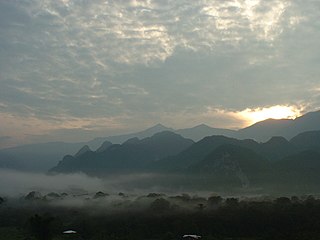
The Gunung Mulu National Park is a national park in Miri Division, Sarawak, Malaysia. It is a UNESCO World Heritage Site that encompasses caves and karst formations in a mountainous equatorial rainforest setting. The park is famous for its caves and the expeditions that have been mounted to explore them and their surrounding rainforest, most notably the Royal Geographical Society Expedition of 1977–1978, which saw over 100 scientists in the field for 15 months. This initiated a series of over 20 expeditions now named the Mulu Caves Project.

The Naica Mine of the Mexican state of Chihuahua, is a lead, zinc and silver mine. Located in Naica in the municipality of Saucillo, the Naica Mine is owned by Industrias Peñoles, the world's largest silver producer. Caverns discovered during mining operations contain gigantic crystals of CaSO
4 · 2 H
2O (calcium sulfate dihydrate, gypsum, also sometimes called selenite. Peñoles announced in October 2015 that it was indefinitely suspending operations due to uncontrollable flooding at the Naica Mine.
Gunung Buda National Park is a national park located in Limbang Division, Sarawak, Malaysia. It is located to the north of Gunung Mulu National Park. Gunung Buda National Park was gazetted in 2001. As in September 2017, the national park was in the planning stage for tourism activities. Roads were also planned to connect Gunung Buda with Gunung Mulu National Park. Gunung Buda meaning White Hill in Lun Bawang language.
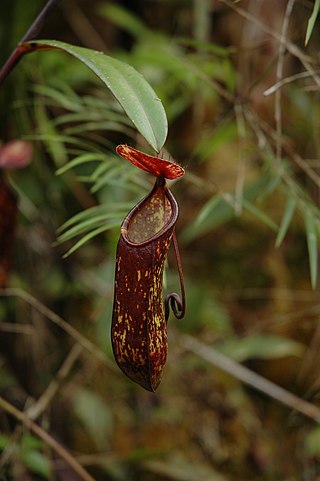
Nepenthes muluensis, or the Mulu pitcher-plant, is a tropical pitcher plant endemic to Borneo. It grows in highland habitats at elevations of 1700 to 2400 m above sea level.
Mount Benarat is a mountain located in Gunung Mulu National Park in Sarawak, Malaysia, consisting of limestone on the western side which is overlain by gritstone on the eastern side. It contains many caves which have been discovered and explored by British and American cavers. The Benarat 2005 Caving Expedition discovered Moon Cave after climbing 60 m up the cliffs on the southern end of the mountain. On the eastern side, the Headhunter's Trail leads from the Melinau River to the mouth of the Terikan River at the Medalam River. Neighbouring Mount Buda and Mount Api are part of the same formation, separated from Mount Benarat by the Medalam and Melinau Rivers, respectively. It is also home to Benarat Cavern.
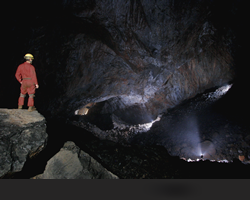
Api Chamber is a chamber in Whiterock Cave in Mount Api, Gunung Mulu National Park, Sarawak, Malaysia. Measuring 300 m by 200 m and with a surveyed circumference of 900 m it is the ninth largest cave chamber by area in the world. Its height is over 100 m and its plan area is 58,000 square metres. It is the second largest chamber in Malaysia after Sarawak Chamber.

Moaning Caverns is a solutional cave located in the Calaveras County, California, near Vallecito, California in the heart of the state's Gold Country. It is developed in marble of the Calaveras Formation. It was discovered in modern times by gold miners in 1851, but it has long been known as an interesting geological feature by prehistoric peoples. It gets its name from the moaning sound that echoed out of the cave luring people to the entrance, however expansion of the opening to allow access for the public disrupted the sounds. The portion of the cave developed for tourists consists of a spacious vertical shaft 165 feet tall, which is descended by a combination of stairs and a unique 100-foot-high (30 m) spiral staircase built in the early 1900s. It is open to the public for walking tours and spelunking. Including the off-trail areas, the cave reaches a depth of 410 feet.
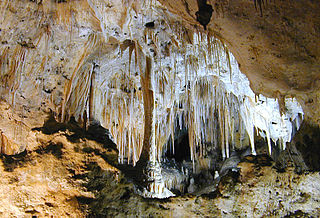
Carlsbad Caverns National Park is an American national park in the Guadalupe Mountains of southeastern New Mexico. The primary attraction of the park is the show cave Carlsbad Cavern. Visitors to the cave can hike in on their own via the natural entrance or take an elevator from the visitor center.
Pelophryne api, also known as Api dwarf toad, is a species of toad in the family Bufonidae. It is endemic to Borneo and known from Gunung Mulu National Park in northern Sarawak and from Simpang Kuda in Bau District, western Sarawak. Its genetic divergence from Pelophryne guentheri is relatively low and these species could be conspecific.
Gua Nasib Bagus or Lubang Nasib Bagus is a cave located in the state of Sarawak in Malaysia. It is one of many caves found within Gunung Mulu National Park, a World Heritage Site on the island of Borneo.
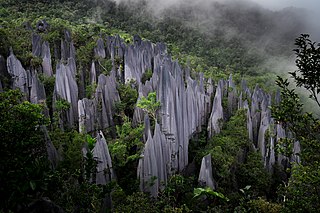
Mount Api is a limestone mountain located in Gunung Mulu National Park in Sarawak, Malaysia. Neighbouring Mount Benarat and Mount Buda are part of the same formation. Mount Api is famous for its striking limestone karst formations, commonly called "the pinnacles".

Deer Cave, located near Miri, Sarawak, Malaysia, is a show cave attraction of Gunung Mulu National Park. It was surveyed in 1961 by G. E. Wilford of the British Borneo Geological Survey, who predicted that Mulu would yield many more caves in the future. The cave, which is also known as Gua Payau or Gua Rusa by the local Penan and Berawan people, is said to have received its name because of the deer that go there to lick salt-bearing rocks and shelter themselves.

Cave of the Crystals or Giant Crystal Cave is a cave connected to the Naica Mine at a depth of 300 metres (980 ft), in Naica, Chihuahua, Mexico. It takes the form of a chamber within the limestone host rock of the mine, and is about 109 metres (358 ft) long with a volume of 5,000 to 6,000 cubic metres.

The Borneo lowland rain forests is an ecoregion, within the tropical and subtropical moist broadleaf forests biome, of the large island of Borneo in Southeast Asia. It supports approximately 15,000 plant species, 380 bird species and several mammal species. The Borneo lowland rain forests is diminishing due to logging, hunting and conversion to commercial land use.
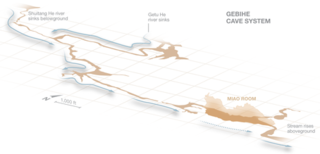
Miao Room is the largest known cave chamber by volume in the world. It is a part of the Gebihe cave system, which is located in Ziyun Getu He National Park in Ziyun county of the Chinese province of Guizhou. The chamber, discovered by a French expedition called Gebihe'89 in 1989, measures 852 metres (2,795 ft) in length, 191 metres (627 ft) in width, has an area of 154,500 square metres (1,663,000 sq ft), and a volume of 10,780,000 cubic metres (381,000,000 cu ft). In 2013, members of a British led expedition measured the chamber using 3-D laser scanners.

The Clearwater Cave System in Gunung Mulu National Park, Sarawak, Malaysia is believed to be one of the world's largest interconnected cave systems by volume and its 9th longest at 236.796 km (147.138 mi) (2020). The system lies mainly under the western margins of Gunung Api between the Melinau Gorge and Cave of the Winds.
Lithocarpus muluensis is a tree in the beech family Fagaceae. It is named for Gunung Mulu mountain in Sarawak, Borneo.
Ilex megaphylla is a tree in the holly family Aquifoliaceae, native to Borneo. The specific epithet megaphylla means "large leaves".
References
- ↑ "Mulu Caves Project » Mulu '80" . Retrieved 29 March 2017.
- ↑ Kirby (2011:23)
- ↑ Gunung Mulu World Heritage Area, Cave activities Archived 2012-07-29 at the Wayback Machine
- ↑ Webb, Barry. "The Geology of Mulu". The Mulu Caves Project. Mulu Caves Project 2009. Retrieved 28 September 2014.
- ↑ Mouret, Claude. "The Formation of Large Chambers, With Examples from Laos and Other Countries" (PDF). Speleo Brazil 2001. Retrieved 28 September 2014.
- ↑ Gilli, Eric (1993). "Les grands volumes souterrains du massif de Mulu". Karstologia. 22– via Researchgate.
- Kirby, Matt (2011), Mulu Caves 2011, Mulu Caves Project.
- Jackson [ed], Underground Worlds (1985) Time Life Books. Earth Series.
- Meredith, Wooldridge and Lyon, Giant Caves of Borneo (1992) Tropical Press.
- Facts and Fallacies - Stories of the Strange and Unusual (1989). Reader's Digest Ltd. pp. 14–15. ISBN 0-86438-087-9.
- Extreme Earth Collins (2003) Pp. 78–79. ISBN 0-00-716392-4
- House of Leaves (2000) p. 125.